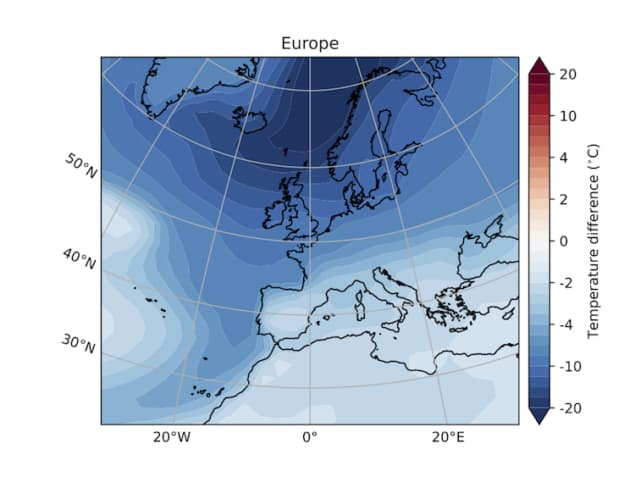
The collapse of the main ocean current that keeps Europe warmer than other regions at similar latitudes is a real possibility, say researchers at Utrecht University in the Netherlands – though they remain unsure when it might happen. The researchers based their conclusions on a modern complex physics-based climate model that incorporates the gradual melting of ice sheets, and they say that the collapse, when it occurs, could have far-reaching consequences not only for Europe, but for the southern hemisphere, where temperatures could rise without the current’s heat-distributing effects.
Led by physicist René van Westen, the researchers focused on a phenomenon known as the Atlantic meridional overturning circulation (AMOC). The AMOC moves warm and cold water around the Atlantic Ocean, and it involves warm water, which is slightly saltier because of evaporation, flowing north from the tropics along the ocean’s surface. The density of this salty water is higher than that of fresh water, so as the water cools, it sinks. It then returns to the tropics and the southern hemisphere, this time passing deep along the ocean bed.
Among other things, this pattern of warm and cold flows means that the UK and other countries in northern Europe have temperate climates – unlike, say, Labrador in north-eastern Canada, which is much cooler despite being at almost the same latitude.
More freshwater in the ocean
The team’s modelling, which is based on the Community Earth System Model and performed over a period of six months on the Netherlands’ national supercomputer, Snellius, has now revealed a “tipping point” in the AMOC that could cause it to collapse over the course of around 100 years. One possible cause for this tipping would be the melting of ice sheets, which would allow large amounts of freshwater to enter the North Atlantic, reducing the ocean’s salinity and thus its density. In this scenario, the less-dense water would not sink as much during its journey back to the tropics, and the entire system would shift into a different pattern.
Modelling such a scenario is no easy task, however, and previous attempts relied on introducing unrealistically large amounts of freshwater, unrealistically quickly. The new simulations, which are the most sophisticated yet in considering how melting ice sheets could cause the AMOC to collapse, introduce freshwater gradually rather than all at once, says Westen. For example, between model year 0 and model year 2220, the model linearly increases the flux of freshwater at latitudes between 20°N and 50°N at a rate of 3 × 10−4 Sverdrups (Sv) per year, where 1 Sv is equivalent to 106 cubic metres per second.
“Such a simulation has not been conducted before within conventionally employed global climate models like the Coupled Model Intercomparison Project (CMIP5), for example, because of the high computational costs involved,” Westen says.
On a path towards tipping
The researchers found that the strength of the AMOC decreased gradually over the first 400 years they modelled. Then, after model year 800, a clear negative trend developed because of the increasing amounts of freshwater being introduced. At the 1750-year mark, the team observed the AMOC collapse from a flow rate of about 10 Sv to 2 Sv by model year 1850. The flow rate eventually became slightly negative after model year 2000.
Such a fast AMOC response is, Westen says, “spectacular considering the small flux of freshwater we introduce in our model”. What is more, Westen adds that present-day real-world data on the AMOC indicates that its strength is already decreasing. “This means we are moving closer to the tipping point and are thus on route for tipping,” he tells Physics World.
According to the team’s calculations, if the AMOC did shut down, temperatures in London, UK could cool by 10 °C on average, while Bergen, on Norway’s west coast, could see a 15 °C drop. Sea levels would rise by 70 cm along the US East Coast, while the Amazon region would see its rainy and dry seasons flip, severely disrupting its ecosystem.
“Not just a theoretical concept”
The researchers acknowledge that according to their model, overturning the AMOC would take a lot of freshwater and many hundreds of years. That said, they point out that their model might not fully reflect real-world circumstances, and add that non-linear effects – in which a small (and perhaps currently undocumented) trigger produces disproportionately large consequences – should not be discounted.

North Atlantic ocean currents are slowing
“One of the most important findings in our work is that AMOC tipping is possible and that it is not just a theoretical concept,” Westen emphasizes. “We hope that other research groups will conduct their own simulations with different models and confirm our results.”
In their present work, which is detailed in Science Advances, the AMOC tipping event was induced in an idealized model where the freshwater input in the North Atlantic increases slowly. The next step, say the researchers, would to be to induce the event in a way that takes climate change into account and better represents how it would quantitatively affect ice sheet melting. “Such a calculated collapse would be much more realistic,” Westen says.



